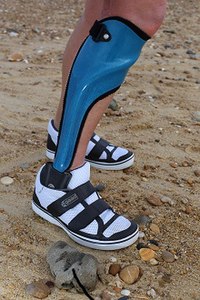
Photo from wikipedia
Several works have been reported in powered hand orthosis in the last ten years for assistive or rehabilitative purposes. However, most of these approaches uses conventional actuators such as servo… Click to show full abstract
Several works have been reported in powered hand orthosis in the last ten years for assistive or rehabilitative purposes. However, most of these approaches uses conventional actuators such as servo motors to power orthosis. In this work, we demonstrate the recently reported twisted and coiled polymeric (TCP) muscles to drive a compact, light, inexpensive and wearable upper extremity device, iGrab. A 3D printed orthotic hand module was designed, developed and tested for the performance. The device has six 2-ply muscles of diameter 1.35 mm with a length of 380 mm. We used a single 2-ply muscle for each finger and two 2-ply muscles for the thumb. Pulsed actuation of the muscles at 1.8 A current for 25 s with 7% duty cycle under natural cooling showed full flexion of the fingers within 2 s. Modeling and simulation were performed on the device using standard Euler–Lagrangian equations. Our artificial muscles powered hand orthosis demonstrated the capability of pinching and picking objects of different shapes, weights, and sizes.
Journal Title: Smart Materials and Structures
Year Published: 2017
Link to full text (if available)
Share on Social Media: Sign Up to like & get
recommendations!